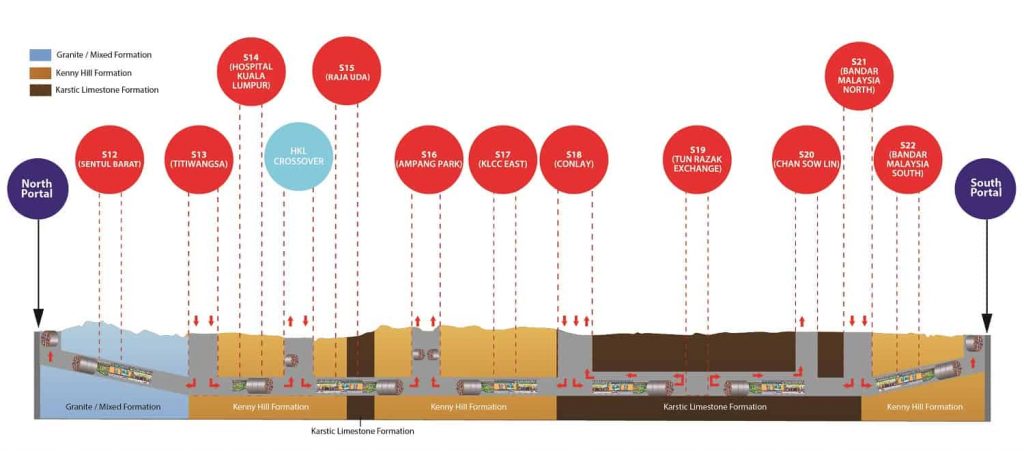
Tunnelling Challenges
The biggest challenge in our underground construction works are the geological formations beneath Kuala Lumpur. For the MRT Putrajaya Line project, tunnelling works primarily face three types of key geological formations, namely Kenny Hill, Karstic Limestone and Granite, with most of the tunnel alignment situated in Grade V karstic limestone.
Extreme karst limestone is a geological formation formed through the gradual erosion of limestone by mildly acidic water over millions of years, leaving behind an elaborate labyrinth of unstable caverns, cliffs and pinnacles that run beneath the depths of Kuala Lumpur city. Due to the void-riddled nature of these underground passages, some cavities may become filled with water. Sinkholes and ground subsidence can then occur when disturbances to these underground water tables cause earth and other debris to shift, disrupting the equilibrium of the system.
With such unpredictable and complex geological conditions at play, controlling ground loss and pressure fluctuations in the midst of tunnelling works is vital to avoid sinkholes, reduce settlement and limit the impact on existing structures. To tackle these complex conditions, MMC Gamuda relies on our Variable Density (VD) Tunnel Boring Machine (TBM) (the first in the world when innovated during the MRT Kajang Line project) which is able to operate in multiple modes.
Geological Formations
Karstic Limestone
The main challenge of tunnelling in limestone is the difficulty in controlling the sudden loss of face pressure when encountering underground voids and channels, resulting in surface settlement or sinkholes.
This is mitigated via extensive geological mapping and investigations plus carefully designed ground treatment before tunnelling starts. The Variable Density (VD) TBM slows down the sudden loss of face pressure by injecting high density slurry to prevent blowouts into the surface through underground channels.
Karstic Limestone
Kenny Hills
This geological formation consists of mainly sandy silt and sandstones with sporadic intrusions of quartz lens or dyke. It is generally considered to be stable for tunnelling. However due to the abrasive characteristics of this geological type, the challenge is then infrequent wear and tear to the TBM’s cutting tools. The Earth Pressure Balance machine however is well-suited for this geological formation.
Kenny Hills
Granite
Granite is generally hard and abrasive, thus mining through it requires regular maintenance and a changing of tools, resulting in slower production rates. Weathering of underground granite may also result in fractures where water channels are trapped and hidden, causing conditions similar to karstic limestone. The use of the VD TBM effectively manages such mixed-geological conditions and prevents a sudden drawdown of groundwater which tends to cause ground instability.
Granite
Geological Profile of MRT Putrajaya Line Alignment

